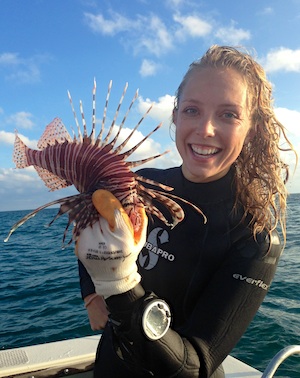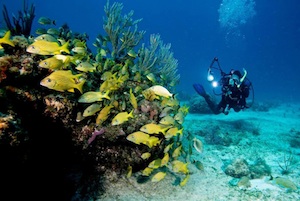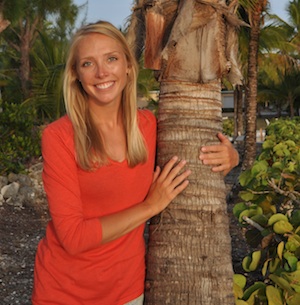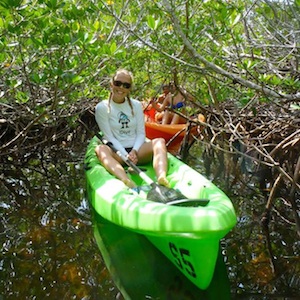Keri Kenning: One Fish, Two Fish, See Fish, Count Fish!
A millennial-age young professional passionate about making epic achievements, 24-year-old Kansas native Keri Kenning sets the bar high. As well as a dizzying array of outdoor interests such as snorkeling, diving, kayaking, fly-fishing, biking and photography, she also pursues underwater objectives driven by mathematical models, counting fish and surveying coral heads.
"Diving is great, but volunteering underwater is better," said Kenning, a resident of Key Largo since 2012. "Whether it's for pleasure or for volunteer work, the majority of my dive log is some kind of research, including lionfish monitoring, lionfish capturing and tagging, or fish counting.
"It's definitely more exciting than normal diving — always fun to have an objective," she added.
Kenning's father, a diving enthusiast and underwater photographer, introduced her to the water at an early age. A fun-fish identification class with her parents and two siblings during a family trip to Bonaire ignited her fiery passion for fish, invertebrates and corals at age 10. This led to Kenning's pursuit of her diving certification a few short years later.
"I really enjoy seeing the underwater habitats and learning how these animals all live and interact together," she explained.
While a biology undergrad at the University of Kansas in 2011, Kenning experienced a semester-long program at the School for Field Studies in the Turks and Caicos Islands that fortified her love of marine science and conservation. There she learned about human impacts on marine resources as well as conservation, environmental policy, socioeconomic values and the impacts of lionfish on the reefs through density surveys, habitat assessments and dissections.
But it was not until a post-graduation dive trip to Belize that Kenning met Lad Akins, director of the Key Largo-based Reef Environmental Education Foundation, along with other leading lionfish researchers. Kenning applied for and was granted a REEF internship and has served as the nonprofit organization's communications manager, teaching fish identification classes and the how-tos of lionfish collecting, conducting U.S.-based workshops and planning lionfish derbies.
Kenning also is an elite member of REEF's Advanced Assessment Team of divers who have achieved expert status at fish identification. She recently completed fish count dives in Little Cayman as well as on the Gen. Hoyt S. Vandenberg off Key West, where REEF has been tasked with monitoring recruitment of fishes to the artificial reef in the five years since its sinking in May 2009. Her rewarding adventures continued at Key Largo's MarineLab where she taught marine science to grade school-age through college-age students, both in the classroom and in the field.
"I really want to stay involved and volunteer as much as I can," Kenning said. "Divers my age and all ages can volunteer with fish counts, lionfish removals, the Coral Restoration Foundation and cleanup dives."
Kenning emphasized that high school students often are required to earn community service hours for activities such as picking up trash or fundraising at a carwash. Many are most excited, however, to learn they can earn a semester's worth of community service hours for snorkeling — doing REEF fish surveys, collecting data and even submitting their captured data online.
"It seems that now more than ever our oceans and coral reefs need help," she said. "Things are changing."
The importance of volunteering to do fish counts, Kenning added, is that these changes are then reported to scientists and policy makers who can help make effective management decisions to conserve marine resources.
She refers to herself as a human sponge, "squeezing out" everything she takes in to pass along for others to enjoy.
"I encourage divers, both young and old, to take up fish watching because it will transform the way you dive," she said. "By learning the names, behaviors, and hiding holes of fish and invertebrates, you personify them. By giving a personality to sea creatures, you're more likely to value and respect them, to conserve and protect them. You can't love what you don't know, and you won't protect what you don't know."
Kenning's approach to life in the Keys is equally exuberant.
"There's a lot to love about the Keys ... so many outdoor activities," she said. "I've never been healthier because I'm always on the go adventuring somewhere."
Despite her active lifestyle, she also enjoys the relaxed pace and laid-back people she encounters in her Keys home.
"The colors and the sights and the smells — it's a very vibrant place down here," said the vivacious Kenning. "Always sunny, always happy."

Kenning is passionate about the How-To’s of lionfish collecting, and encourages recreational divers to participate in lionfish capture events, such as derbies.

Kenning on one of her recreational research dives. Image: Carlos Estape

For Kenning, the The slower pace of life in Key Largo is very relaxing.

Outdoor living in the Keys means snorkeling, diving, kayaking, flyfishing, biking and photography.
